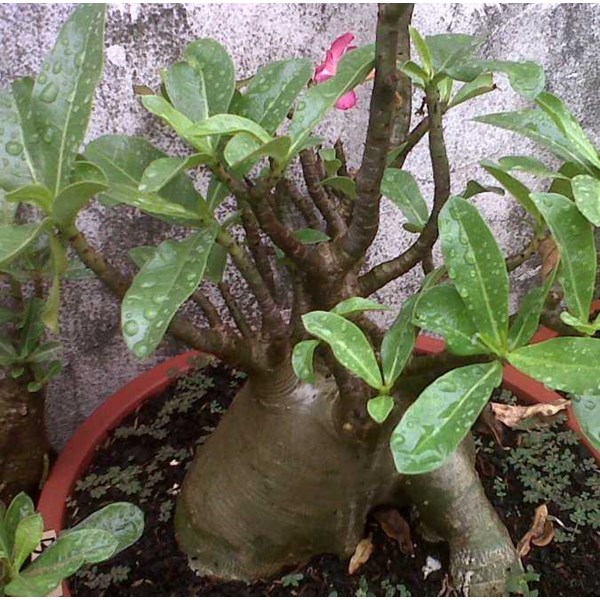Adenium arabicum ultra rare cultivars mix - 5 seeds



Adenium arabicum ultra rare cultivars mix - 5 seeds
Adenium arabicum ia a remarkable succulent plant with a grotesquely swollen trunk which resembles a miniature baobab tree. It is a local or morphological form of Adenium obesum, but commonly used to be know as a separate species and very popular with 'fat plant' collectors. Adenium arabicum is similar in appearance to Adenium obesum, but creates a massive, more squat and fat caudex without much differentiation between trunk and branches and is the most succulent and "desert like" species. The fleshy trunks and short naked branches are also somewhat more coloured in purple to dark brown. It also has larger thick fleshy leaves shiny on the upper and lower surface, unlike Adenium obesum and is an extremely drought tolerant plant.
Flowers, similar in many ways to those of Frangipani, range from pink to red and sparkles when sunlight shines on them. The form of the plant varies in habit and most plants in cultivation are hybrids, yet only a few cultivar names have a valid description. Plants grown from seed produce the most amazing shapes of caudex on just 10 years. It is monoecious and self-sterile.
Adenium arabicums plant grows a squat fat form caudex with many branches growing from the caudex. The fat caudex and many branches gives little differentiation between trunk and branches. The leaves are shiny on the upper and lower surface, unlike Adenium obesum. The skin on the plant is has a more purple to dark brown coloration. The pink to deep red number in hundreds on a mature arabicum, flowering succulent, plant due to their many branches coming up from the caudex.
Also, unlike adenium obesums, the adenium arabicum plant makes a perfect base for a true bonsai form. Yes, you can grow a canopy form using adenium obesums but its a bit more difficult to get a full canopy with a plant with on main trunk. In the image of the adenium arabicum plant you will notice its hard to determine where the caudex ends and trunk begins. As the plant grows the caudex get a bit taller so the many branches coming out of the caudex create a canopy that you wire outwards.
Originally from arid to semi-arid regions, Adenium obesum is nonetheless frequently cultivated in humid tropical or semi-tropical areas. It is nearly evergreen if grown in a warm greenhouse or tropical conditions a and watered, but can loose its leaves and forced into a long winter dormancy in cooler climate. New growth begins early in spring. Outdoors it thrives on a xeric watering regime as required by cacti. Under ideal conditions, it can live for hundreds of years.
It like pots with generous drain holes on sides and bottom, need a very porous potting medium media (add pumice, vulcanite, perlite, sand or brick chips into regular soil, or a cactus mix) seeing that the main trunk is planted with the majority of the roots below the caudex line. Its rare that adeniums will use the upper third of their soil and often this area serves like a mulch or support for the stem. Avoid choosing a very deep pot as this might encourage an oblong (carrot-shaped) underground caudex. Outdoors they adapt to a wide range drained soils.
To make plants develop a large swollen base/trunk and to increase flowering, they require a fertilizer rich in potassium, phosphorus and micronutrient without a too high nitrogen content. Fertilize regularly while the plant is growing.
Bright filtered light is best but in areas where light is not as burning, plants may be kept outdoors in full sun unprotected but remember that caudex is very susceptible to sun scalding. Plant becomes leggy in the shade and its flowering reduced.
Water: Water plants preferably in the early mornings until the soil is well wetted and let excess water drains from the pot base. Watering can be done as they become drier during active growth season. Never allow plants to dry out too often as this causes them to go into early dormancy. Many plants simply never get enough water to grow and flower adequately so keep them active and growing by providing them with all the essential necessities. Water sparingly during winter months.
Hardiness: It is frost sensitive and cannot endure freezing temperatures (U.S.D.A. Zone: 10a-12). If temperatures regularly fall below 2° C, the plant should be grown in a container for moving into a cold protected area. Partial defoliation may also occur at other times in response to weather change. As an indoor plant ensures a minimum temperature in winter of 10 °C. Where year-round temperature is sufficiently warm, desert rose will not become dormant and deciduous and may be ever-blooming.
They should be re-potted frequently until they attain their desired size. Plant appearance varies from plant to plant so prune accordingly. Pruning above the leaves is more likely
to produce multiple branching than pruning further down on the plant on bare stem. Pinching or pruning should be done once a year during the growing season. Pruning during winter often fails to generate robust branching.
